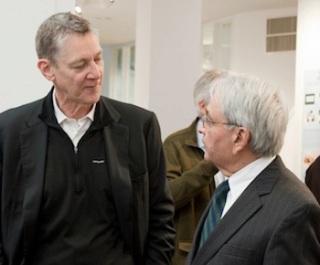Feb 23 2015
In a wide-ranging lecture delivered in a building he helped to design, architect James Timberlake talked with members of the Rice University community about how he and his partners transform vision into reality.
 James Timberlake, left, and sponsor Randhir Sahni '71 talk at a reception before Timberlake's lecture at Rice's Brockman Hall for Physics. Timberlake's firm designed the award-winning Brockman Hall and is working on an integrated campus plan for the university. Photo by Tami Lynn Andrew
James Timberlake, left, and sponsor Randhir Sahni '71 talk at a reception before Timberlake's lecture at Rice's Brockman Hall for Physics. Timberlake's firm designed the award-winning Brockman Hall and is working on an integrated campus plan for the university. Photo by Tami Lynn Andrew
Timberlake is a principal of the Philadelphia-based firm KieranTimberlake, which designed Rice’s award-winning Brockman Hall for Physics, the site of the lecture, and is responsible for the in-progress Integrated Campus Plan at Rice.
The Llewelyn-Davies Sahni Innovative Practices Lecture on Feb. 18 was part of the Rice School of Architecture‘s spring lecture series titled “Contemporary” and was sponsored by architect Randhir Sahni ’71. The full lecture will be posted on the school’s website.
Timberlake said he was pleased to be back at Brockman, especially after its recent recognition as one of 11 buildings in the world to win an American Institute of Architects 2015 Honor Award.
“Like many architects, when you design a house, you always want to go to that house and sleep overnight, just to get the general sense of being in that place that you’ve thought about and envisioned and created,” he said. “So it’s great to be in this room.
“One of the great things about making this building is that we sort of embedded ourselves with the physics and engineering people on this campus,” he said. “We didn’t become part of the faculty, but we certainly came to understand how they go about doing what they do, and to this day we can probably talk about some of that stuff, in some ways, better than they could.”
Timberlake took the audience through past, present and future projects by his firm and offered an extended analysis of Brockman as well as the design of the United States Embassy on London’s South Bank; the revitalization of Bangladesh and its capital city, Dhaka, under the threat of rising seas from global warming; and the data-intensive analysis of the Rice campus as preparation for its future.
He emphasized that gathering, organizing and applying data is more important than ever to architects. “Data is a gold mine and data is what’s going to drive this practice … as we go forward,” Timberlake said. He gave examples about how extensive investigations laid the groundwork not only for Brockman but also for the under-construction London embassy, the Bangladesh project (a cooperative effort with an architecture studio at the University of Pennsylvania) and the Rice plan.
Timberlake said original architect Ralph Cram gave Rice a “wonderful template” upon which to build. Of the new initiative, he said, “It’s not so much a master plan as it is Rice’s rethinking of what a master plan is.”
He said the integrated plan is a framework for future growth “that’s highly unique to Rice University. There’s no other university that has this tool.” The interactive database at the heart of the plan incorporates logistics on open space, built space, circulation, stormwater and energy usage.
“We developed a three-dimensional model and then created a dataset dashboard that allows us to rearrange the pieces as Rice sees what it needs to do over the course of the next 100 years,” Timberlake said. As an example, he described how incorporating a rise in student enrollment into the model would show the effect on all of the other parameters, like water and energy usage, to give administrators a better idea of costs.
“You now have an incredibly flexible document that can talk to you over time about how to utilize the rest of the campus,” he said.